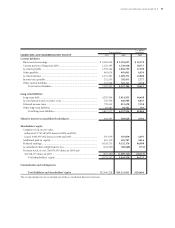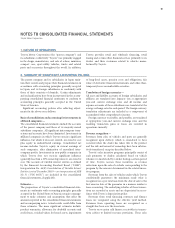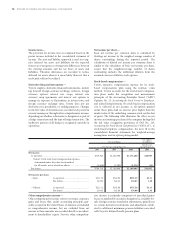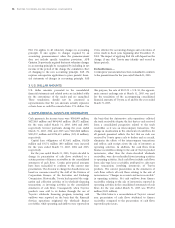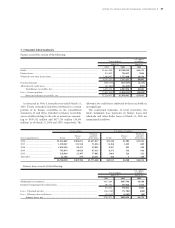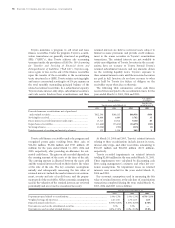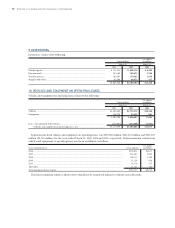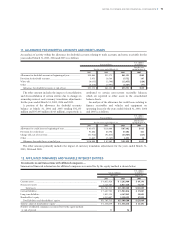Toyota 2005 Annual Report Download - page 88
Download and view the complete annual report
Please find page 88 of the 2005 Toyota annual report below. You can navigate through the pages in the report by either clicking on the pages listed below, or by using the keyword search tool below to find specific information within the annual report.
86 >NOTES TO CONSOLIDATED FINANCIAL STATEMENTS
FAS 154 applies to all voluntary changes in accounting
principle. It also applies to changes required by an
accounting pronouncement when the pronouncement
does not include specific transition provisions. APB
Opinion 20 previously required that most voluntary changes
in accounting principle be recognized by including in net
income of the period of the change the cumulative effect
of changing to the new accounting principle. FAS 154
requires retrospective application to prior periods’ finan-
cial statements of changes in accounting principle. FAS
154 is effective for accounting changes and corrections of
errors made in fiscal years beginning after December 15,
2005. The impact of applying FAS 154 will depend on the
change, if any, that Toyota may identify and record in
future periods.
Reclassifications—
Certain prior year amounts have been reclassified to conform
to the presentations for the year ended March 31, 2005.
U.S. dollar amounts presented in the consolidated
financial statements and related notes are included solely
for the convenience of the reader and are unaudited.
These translations should not be construed as
representations that the yen amounts actually represent,
or have been or could be converted into, U.S. dollars. For
this purpose, the rate of ¥107.39 = U.S. $1, the approxi-
mate current exchange rate at March 31, 2005, was used
for the translation of the accompanying consolidated
financial amounts of Toyota as of and for the year ended
March 31, 2005.
3. U.S. DOLLAR AMOUNTS
Cash payments for income taxes were ¥584,969 million,
¥627,483 million and ¥694,985 million ($6,472 million)
for the years ended March 31, 2003, 2004 and 2005,
respectively. Interest payments during the years ended
March 31, 2003, 2004 and 2005 were ¥216,888 million,
¥203,257 million and ¥226,615 million ($2,110 million),
respectively.
Capital lease obligations of ¥13,461 million, ¥4,826
million and ¥3,571 million ($33 million) were incurred
for the years ended March 31, 2003, 2004 and 2005,
respectively.
For the year ended March 31, 2005, Toyota decided to
change its presentation of cash flows attributed to a
certain portion of finance receivables in the consolidated
statements of cash flows. Certain prior-period amounts
have been reclassified to conform to the current year
presentation. The decision to change the classification was
based on concerns raised by the staff of the Division of
Corporation Finance of the Securities and Exchange
Commission. Historically, Toyota had reported the origi-
nation and collection activities of its wholesale financing
transactions as investing activities in the consolidated
statements of cash flows. Consequently, when Toyota’s
products were sold to its dealers through the use of
Toyota’s wholesale financing program, investing cash
outflows were reported on the basis that the Financial
Services operations originated the wholesale finance
receivables, while operating cash inflows were reported on
the basis that the Automotive sales operations collected
the trade receivables despite the fact that no cash received
from a consolidated perspective related to the trade
receivables as it was an intercompany transaction. The
change in classification in the statements of cash flows for
all periods presented reflects the fact that no cash was
received by Toyota upon a sale to dealers and as a result,
eliminates the effects of the intercompany transactions
and reflects cash receipts from the sale of inventory as
operating activities. In addition, the cash flows from
finance receivables relating to the sale of Toyota product
inventories, other than the above-described wholesale
receivables, were also reclassified from investing activities
to operating activities. Such cash flows include cash flows
from sales-type lease receivables attributed to sales-type
lease transactions involving inventories of Toyota
products. The current presentation in the statements of
cash flows reflects all cash flows relating to the sale of
inventories as “Changes in accounts and notes receivable”
in operating activities. Net cash outflows from finance
receivables relating to the sale of inventories reported in
operating activities in the consolidated statements of cash
flows for the year ended March 31, 2005 was ¥55,951
million ($521 million).
The table below is a reconciliation of Toyota’s current
year presentation of cash flows attributed to finance
receivables compared to the presentation of cash flows
reported in prior years.
4. SUPPLEMENTAL CASH FLOW INFORMATION



